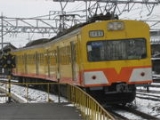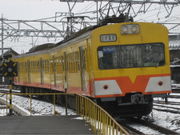
Sangi Railway
Encyclopedia


Mie Prefecture
is a prefecture of Japan which is part of the Kansai regions on Honshū island. The capital is the city of Tsu.- History :Until the Meiji Restoration, Mie prefecture was known as Ise Province and Iga Province....
, Japan
Japan
Japan is an island nation in East Asia. Located in the Pacific Ocean, it lies to the east of the Sea of Japan, China, North Korea, South Korea and Russia, stretching from the Sea of Okhotsk in the north to the East China Sea and Taiwan in the south...
. It also operates bus
Bus
A bus is a road vehicle designed to carry passengers. Buses can have a capacity as high as 300 passengers. The most common type of bus is the single-decker bus, with larger loads carried by double-decker buses and articulated buses, and smaller loads carried by midibuses and minibuses; coaches are...
lines. The company was founded in 1928. Its original line, the Sangi Line, mainly functioned as a freight line transporting cement
Cement
In the most general sense of the word, a cement is a binder, a substance that sets and hardens independently, and can bind other materials together. The word "cement" traces to the Romans, who used the term opus caementicium to describe masonry resembling modern concrete that was made from crushed...
, but in recent years, it also became important as a commuter railway line for Yokkaichi
Yokkaichi, Mie
is a city located in Mie, Japan.As of October 1, 2010, the city has an estimated population of 314,393. The total area is 205.53 km².The closest major city is Nagoya in Aichi Prefecture....
. The Hokusei Line
Sangi Railway Hokusei Line
The , commonly known as the Sangi Hokusei Line, is a railway line of the Japanese private railway company Sangi Railway, connecting Nishi-Kuwana Station and Ageki Station in Japan...
was transferred from Kintetsu
Kintetsu
, named Kinki Nippon Railway Co., Ltd. in English until June 27, 2003, is a Japanese rail transit corporation commonly known as . It is the largest non-JR railway in Japan. Its complex network of lines connects Osaka, Kyoto, Nara, Nagoya, Tsu and Ise...
ownership in 2003, when Kintetsu abandoned the line. Whereas the Sangi Line has a track gauge of , the Hokusei Line is one of only a few narrow gauge lines in the country.
EMUs
- 801 series - Former SeibuSeibu Railwayis a conglomerate based in Tokorozawa, Japan, with principal business areas in railways, tourism and real estate. Seibu Railway's operations are concentrated in northwest Tokyo and Saitama Prefecture; the name "Seibu" is an abbreviation of "west Musashi," referring to the historic name for this area...
701 series trains acquired in 1989 - 101 series - Former Seibu 401 series trains acquired in 1990
- 851 series - Former Seibu 701 series trains acquired in 1995
- 751 series 3-car EMUs - Former Seibu 101 series trains acquired in 2009
Electric locomotives
- ED45 class - Since 1954 (includes former Tobu RailwayTobu Railwayis a Japanese commuter railway company in the Greater Tokyo Area as well as an intercity and regional operator in the Kantō region. It operates in Tokyo, Saitama, Chiba, Tochigi, and Gunma Prefectures...
locomotives) - ED301 class - Former NankaiNankai Electric Railwayis a private railway in Japan. IC cards are accepted.Nankai Railway Company was founded on June 16, 1884, then became one of the companies that merge to form Kinki Nippon Railway Co., Ltd. in 1944. However Kin-nichi transferred the former Nankai Railway Company Lines to present Nankai Electric...
ED5201 class acquired in 1984 - DeKi 200 class - Former Chichibu RailwayChichibu Railwayis a small-sector private railway company operating two railway lines in northern Saitama Prefecture, Japan. In addition to its railway operations, the company deals in the real estate and tourism industries. It also manages the Mitsumine Ropeway...
DeKi 200 class acquired in 2000
EMUs
- 130 series - Built in 1954
- 200 series - Built in 1959
- 140 series - Built in 1960
- 270 series - Built in 1977

